Fabrication and Characterization of Superhydrophobic Al-Based Surface Used for Finned-Tube Heat Exchangers
Abstract
:1. Introduction
2. Materials and Methods
2.1. Materials
2.2. Surface Fabrication Process
2.3. Surface Characterization
2.4. Investigation of Durability
3. Results and Discussion
3.1. Fabrication Process Optimization
3.1.1. Influence of Etching Solution Concentration
3.1.2. Process Optimization Based on RSM
3.1.3. Fabrication of Superhydrophobic Finned-Tube Heat Exchanger
3.2. Surface Wettability
3.3. Surface Morphology and Composition
3.4. Durability Property
3.4.1. Air Exposure Test
3.4.2. Corrosion Resistance
3.4.3. Mechanical Robustness Test
3.5. Evaluation of Surface Characteristics
4. Conclusions
- The fabrication process and parameters were improved. The single factor experiments of etching solution concentration provided a reasonable HCl solution concentration of 2 mol/L. The RSM and variance analysis determined the response relationship between etching time, deposition time, drying temperature and contact angle. The optimal manufacturing parameters were the etching time in HCl solution of 10.5 min, the self-assembly time in the stearic acid ethanol solution of 48 h, and drying under 73.0 °C.
- The resulting Al fins have excellent superhydrophobicity. The WCA was 166.9° and the CAH was 3.7°. The area fraction of the air–liquid interface in the superhydrophobic Al surface was 93.5% calculated by Cassie–Baxter model. The free energy of the superhydrophobic fin was 2.53 mN/m.
- The FE-SEM images and 3D topography analysis showed suitable micro-nano structures, and the XPS and FTIR spectra showed the self-assembly of an alkyl chain, which are essential for the realization of the superhydrophobic surface.
- A WCA decay model was established for surfaces exposed to air. At a preset service period of 10 years, the WCA dropped would be 2.4°. In evaluating anti-corrosion performance, the modified fins showed good anti-corrosion properties in the NSS accelerated corrosion test, and the surface maintained superhydrophobicity in acidic to neutral environments. In addition, the Al surface still met the evaluation criteria of superhydrophobicity after the abrasion test.
Author Contributions
Funding
Institutional Review Board Statement
Informed Consent Statement
Data Availability Statement
Acknowledgments
Conflicts of Interest
References
- IEA Buildings A Source of Enormous Untapped Efficiency Potential. Available online: https://www.iea.org/topics/buildings (accessed on 14 August 2021).
- Laohalertdecha, S.; Dalkilic, A.S.; Wongwises, S.; Mechanics, F.; Division, T. A review on the heat-transfer performance and pressure-drop characteristics of various. Int. J. Air-Cond. Refrig. 2012, 20, 1–20. [Google Scholar] [CrossRef]
- Rafati Nasr, M.; Fauchoux, M.; Besant, R.W.; Simonson, C.J. A Review of Frosting in Air-to-Air Energy Exchangers. Renew. Sustain. Energy Rev. 2014, 30, 538–554. [Google Scholar] [CrossRef]
- Wang, Z.; Song, M.; Wang, F.; Ma, Z.; Lin, Q. Experimental Investigation and Seasonal Performance Assessment of a Frost-Free ASHP System with Radiant Floor Heating. Energy Build. 2018, 179, 200–212. [Google Scholar] [CrossRef]
- Ahn, Y.; Lee, J.; Lee, J. Characteristics of Air-Side Particulate Fouling Materials in Finned-Tube Heat Exchangers of Air Conditioners Characteristics of Air-Side Particulate Fouling Materials in Finned-Tube Heat Exchangers of Air Conditioners. Part. Sci. Technol. 2005, 23, 297–307. [Google Scholar] [CrossRef]
- Edelin, D. Experimental Investigation of the Air Side Fouling of Finned Tube Heat Exchangers. Heat Mass Transf. 2019, 55, 2713–2722. [Google Scholar] [CrossRef]
- Zhao, Y.; Qi, Z.; Wang, Q.; Chen, J.; Shen, J. Effect of Corrosion on Performance of Fin-and-Tube Heat Exchangers with Different Fin Materials. Exp. Therm. Fluid Sci. 2012, 37, 98–103. [Google Scholar] [CrossRef]
- Neinhuis, C.; Barthlott, W. Characterization and Distribution of Water-Repellent, Self-Cleaning Plant Surfaces. Ann. Bot. 1997, 79, 667–677. [Google Scholar] [CrossRef] [Green Version]
- Miwa, M.; Nakajima, A.; Fujishima, A.; Hashimoto, K.; Watanabe, T. Effects of the Surface Roughness on Sliding Angles of Water Droplets on Superhydrophobic Surfaces. Langmuir 2000, 16, 5754–5760. [Google Scholar] [CrossRef]
- Ammarullah, M.I.; Afif, I.Y.; Maula, M.I.; Winarni, T.I.; Tauviqirrahman, M.; Akbar, I.; Basri, H.; van der Heide, E.; Jamari, J. Tresca Stress Simulation of Metal-on-Metal Total Hip Arthroplasty during Normal Walking Activity. Materials 2021, 14, 7554. [Google Scholar] [CrossRef]
- Afzali, N.; Taghvaei, E.; Moosavi, A. A Novel and Cost-Effective Method for Fabrication of a Durable Superhydrophobic Aluminum Surface with Self-Cleaning Properties. Nanotechnology 2020, 31, 465708. [Google Scholar] [CrossRef]
- Han, L.; Wu, W.; Huang, Z.; Lei, W.; Li, S.; Zhang, H.; Jia, Q.; Zhang, S. Preparation and Characterization of a Novel Fluorine-Free and PH-Sensitive Hydrophobic Porous Diatomite Ceramic as Highly Efficient Sorbent for Oil–Water Separation. Sep. Purif. Technol. 2021, 254, 117620. [Google Scholar] [CrossRef]
- Chao, Q.; Meng, L.; Shuxian, C. Anti-Icing Characteristics of PTFE Super Hydrophobic Coating on Titanium Alloy Surface. J. Alloy. Compd. 2021, 860, 157907. [Google Scholar] [CrossRef]
- Nguyen, V.-H.; Nguyen, B.D.; Pham, H.T.; Lam, S.S.; Vo, D.-V.N.; Shokouhimehr, M.; Vu, T.H.H.; Nguyen, T.-B.; Kim, S.Y.; Le, Q. Van Anti-Icing Performance on Aluminum Surfaces and Proposed Model for Freezing Time Calculation. Sci. Rep. 2021, 11, 1–9. [Google Scholar] [CrossRef]
- Wu, B.; Cui, X.; Jiang, H.; Wu, N.; Peng, C.; Hu, Z.; Liang, X.; Yan, Y.; Huang, J.; Li, D. A Superhydrophobic Coating Harvesting Mechanical Robustness, Passive Anti-Icing and Active de-Icing Performances. J. Colloid Interface Sci. 2021, 590, 301–310. [Google Scholar] [CrossRef]
- Zhu, Z.; Zhang, Y.; Sun, D.W. Biomimetic Modification of Freezing Facility Surfaces to Prevent Icing and Frosting during Freezing for the Food Industry. Trends Food Sci. Technol. 2021, 111, 581–594. [Google Scholar] [CrossRef]
- Zhu, Y.; Yang, F.; Guo, Z. Bioinspired Surfaces with Special Micro-Structures and Wettability for Drag Reduction: Which Surface Design Will Be a Better Choice? Nanoscale 2021, 13, 3463–3482. [Google Scholar] [CrossRef] [PubMed]
- Gong, W.; Shen, J.; Dai, W.; Li, K.; Gong, M. Research and Applications of Drag Reduction in Thermal Equipment: A Review. Int. J. Heat Mass Transf. 2021, 172, 121152. [Google Scholar] [CrossRef]
- Landel, J.R.; Peaudecerf, F.J.; Temprano-Coleto, F.; Gibou, F.; Goldstein, R.E.; Luzzatto-Fegiz, P. A Theory for the Slip and Drag of Superhydrophobic Surfaces with Surfactant. J. Fluid Mech. 2020, 883, A18. [Google Scholar] [CrossRef] [Green Version]
- Yin, X.; Yu, S.; Bi, X.; Wang, L.; Zang, J.; Zhao, Y.; Wang, B. Preparation of Durable, Self-Cleaning and Photocatalytic Superhydrophobic Ni3S2 Coating on 304 Stainless Steel Surface against Contaminations. J. Mater. Sci. 2021, 56, 6719–6731. [Google Scholar] [CrossRef]
- Pakdel, E.; Wang, J.; Kashi, S.; Sun, L.; Wang, X. Advances in Photocatalytic Self-Cleaning, Superhydrophobic and Electromagnetic Interference Shielding Textile Treatments. Adv. Colloid Interface Sci. 2020, 277, 102116. [Google Scholar] [CrossRef]
- Ragesh, P.; Anand Ganesh, V.; Nair, S.V.; Nair, A.S. A Review on “Self-Cleaning and Multifunctional Materials”. J. Mater. Chem. A 2014, 2, 14773–14797. [Google Scholar] [CrossRef]
- Guo, F.; Duan, S.; Wu, D.; Matsuda, K.; Wang, T.; Zou, Y. Facile Etching Fabrication of Superhydrophobic 7055 Aluminum Alloy Surface towards Chloride Environment Anticorrosion. Corros. Sci. 2021, 182, 109262. [Google Scholar] [CrossRef]
- Qian, H.; Xu, D.; Du, C.; Zhang, D.; Li, X.; Huang, L.; Deng, L.; Tu, Y.; Mol, J.M.C.; Terryn, H.A. Dual-Action Smart Coatings with a Self-Healing Superhydrophobic Surface and Anti-Corrosion Properties. J. Mater. Chem. A 2017, 5, 2355–2364. [Google Scholar] [CrossRef] [Green Version]
- Zhang, X.; Wang, H.; Zhang, X.; Zhao, Z.; Zhu, Y. A Multifunctional Super-Hydrophobic Coating Based on PDA Modified MoS 2 with Anti-Corrosion and Wear Resistance. Colloids Surf. A Physicochem. Eng. Asp. 2019, 568, 239–247. [Google Scholar] [CrossRef]
- Ruan, M.; Li, W.; Wang, B.; Deng, B.; Ma, F.; Yu, Z. Preparation and Anti-Icing Behavior of Superhydrophobic Surfaces on Aluminum Alloy Substrates. Langmuir 2013, 29, 8482–8491. [Google Scholar] [CrossRef] [PubMed]
- Zhu, J. A Novel Fabrication of Superhydrophobic Surfaces on Aluminum Substrate. Appl. Surf. Sci. 2018, 447, 363–367. [Google Scholar] [CrossRef]
- Huang, Y.; Sarkar, D.K.; Grant Chen, X. Superhydrophobic Aluminum Alloy Surfaces Prepared by Chemical Etching Process and Their Corrosion Resistance Properties. Appl. Surf. Sci. 2015, 356, 1012–1024. [Google Scholar] [CrossRef] [Green Version]
- Liu, S.; Ulugun, B.; DeFlorio, W.; Arcot, Y.; Yegin, Y.; Salazar, K.S.; Castillo, A.; Taylor, T.M.; Cisneros-Zevallos, L.; Akbulut, M. Development of Durable and Superhydrophobic Nanodiamond Coating on Aluminum Surfaces for Improved Hygiene of Food Contact Surfaces. J. Food Eng. 2021, 298, 110487. [Google Scholar] [CrossRef]
- Sharma, D.K.; Kumar, R.; Avasthi, D.K.; Sikarwar, B.S. Self Assembly of Super-Hydrophobic Nanotextured Methyl Functionalized Silica on Copper and Aluminium Surfaces for Moist Air Condensation. Colloids Surf. A Physicochem. Eng. Asp. 2020, 605, 125379. [Google Scholar] [CrossRef]
- Yu, R.; Jacobi, A.M. Self-Healing, Slippery Surfaces for HVAC&R Systems. In Proceedings of the 15th International Refrigeration and Air-Conditioning Conference, West Lafayette, IN, USA, 14–17 July 2014. [Google Scholar]
- Wang, Q.; Zhang, B.; Qu, M.; Zhang, J.; He, D. Fabrication of Superhydrophobic Surfaces on Engineering Material Surfaces with Stearic Acid. Appl. Surf. Sci. 2008, 254, 2009–2012. [Google Scholar] [CrossRef]
- Jiaqiang, E.; Jin, Y.; Deng, Y.; Zuo, W.; Zhao, X.; Han, D. Wetting Models and Working Mechanisms of Typical Surfaces Existing in Nature and Their Application on Superhydrophobic Surfaces: A Review. Adv. Mater. Interfaces 2017, 5, 1701052. [Google Scholar] [CrossRef]
- Wang, F.; Li, C.; Lv, Y.; Lv, F.; Du, Y. Ice Accretion on Superhydrophobic Aluminum Surfaces under Low-Temperature Conditions. Cold Reg. Sci. Technol. 2010, 62, 29–33. [Google Scholar] [CrossRef]
- Chen, C.; Yang, S.; Liu, L.; Xie, H.; Liu, H.; Zhu, L.; Xu, X. A Green One-Step Fabrication of Superhydrophobic Metallic Surfaces of Aluminum and Zinc. J. Alloys Compd. 2017, 711, 506–513. [Google Scholar] [CrossRef]
- Peng, H.; Wang, Q.; Wang, T.; Li, L.; Xia, Z.; Du, J.; Zheng, B.; Zhou, H. Study on Dynamics and Freezing Behaviors of Water Droplet on Superhydrophobic Aluminum Surface. Appl. Phys. A 2020, 126, 811. [Google Scholar] [CrossRef]
- Wu, R.; Chao, G.; Jiang, H.; Hu, Y.; Pan, A. The Superhydrophobic Aluminum Surface Prepared by Different Methods. Mater. Lett. 2015, 142, 176–179. [Google Scholar] [CrossRef]
- Resistance, C. One-Step Preparation of Super-Hydrophobic. Metals 2018, 8, 960. [Google Scholar] [CrossRef] [Green Version]
- Xiao, X.; Xie, W.; Ye, Z. Preparation of Corrosion-Resisting Superhydrophobic Surface on Aluminium Substrate. Surf. Eng. 2019, 35, 411–417. [Google Scholar] [CrossRef]
- Feng, L.; Zhang, H.; Wang, Z.; Liu, Y. Superhydrophobic Aluminum Alloy Surface: Fabrication, Structure, and Corrosion Resistance. Colloids Surf. A Physicochem. Eng. Asp. 2014, 441, 319–325. [Google Scholar] [CrossRef]
- Zhang, B.; Wang, J.; Zhang, J. Bioinspired One Step Hydrothermal Fabricated Superhydrophobic Aluminum Alloy with Favorable Corrosion Resistance. Colloids Surf. A Physicochem. Eng. Asp. 2020, 589, 124469. [Google Scholar] [CrossRef]
- Boyina, K.S.; Mahvi, A.J.; Chavan, S.; Park, D.; Kumar, K.; Lira, M.; Yu, Y.; Gunay, A.A.; Wang, X.; Miljkovic, N. Condensation Frosting on Meter-Scale Superhydrophobic and Superhydrophilic Heat Exchangers. Int. J. Heat Mass Transf. 2019, 145, 118694. [Google Scholar] [CrossRef]
- Wang, F.; Liang, C.; Yang, M.; Fan, C.; Zhang, X. Effects of Surface Characteristic on Frosting and Defrosting Behaviors of Fin-Tube Heat Exchangers. Appl. Therm. Eng. 2015, 75, 1126–1132. [Google Scholar] [CrossRef]
- Wang, F.; Liang, C.; Zhang, Y.; Zhang, X. Defrosting Performance of Superhydrophobic Fin-Tube Heat Exchanger. Appl. Therm. Eng. 2017, 113, 229–237. [Google Scholar] [CrossRef]
- Edalatpour, M.; Liu, L.; Jacobi, A.M.; Eid, K.F.; Sommers, A.D. Managing Water on Heat Transfer Surfaces: A Critical Review of Techniques to Modify Surface Wettability for Applications with Condensation or Evaporation. Appl. Energy 2018, 222, 967–992. [Google Scholar] [CrossRef]
- Wang, W.; Zhang, B.; Shi, Y.; Ma, T.; Zhou, J.; Wang, R.; Wang, H.; Zeng, N. Improvement in Chemical Mechanical Polishing of 4H-SiC Wafer by Activating Persulfate through the Synergistic Effect of UV and TiO2. J. Mater. Process. Technol. 2021, 295, 117150. [Google Scholar] [CrossRef]
- Cassie, A.B.D.; Baxter, S. Wettability of Porous Surfaces. Trans. Faraday Soc. 1944, 40, 546–551. [Google Scholar] [CrossRef]
- Owens, D.K.; Wendt, R.C. of Estimation of Polymers. J. Appl. Polym. Sci. 1969, 13, 1741–1747. [Google Scholar] [CrossRef]
- Jung, Y.C.; Bhushan, B. Mechanically Durable Carbon Nanotube—Composite Hierarchical Structures with Superhydrophobicity, Self-Cleaning, and Low-Drag. ACS Nano 2009, 3, 4155–4163. [Google Scholar] [CrossRef]
- Huang, Y.; Li, Y.; Gong, Q.; Zhao, G.; Zheng, P.; Bai, J.; Gan, J.; Zhao, M.; Shao, Y.; Wang, D.; et al. Hierarchically Mesostructured Aluminum Current Collector for Enhancing the Performance of Supercapacitors. ACS Appl. Mater. Interfaces 2018, 10, 16572–16580. [Google Scholar] [CrossRef]
- Feng, L.; Zhang, H.; Mao, P.; Wang, Y.; Ge, Y. Superhydrophobic Alumina Surface Based on Stearic Acid Modification. Appl. Surf. Sci. 2011, 257, 3959–3963. [Google Scholar] [CrossRef]
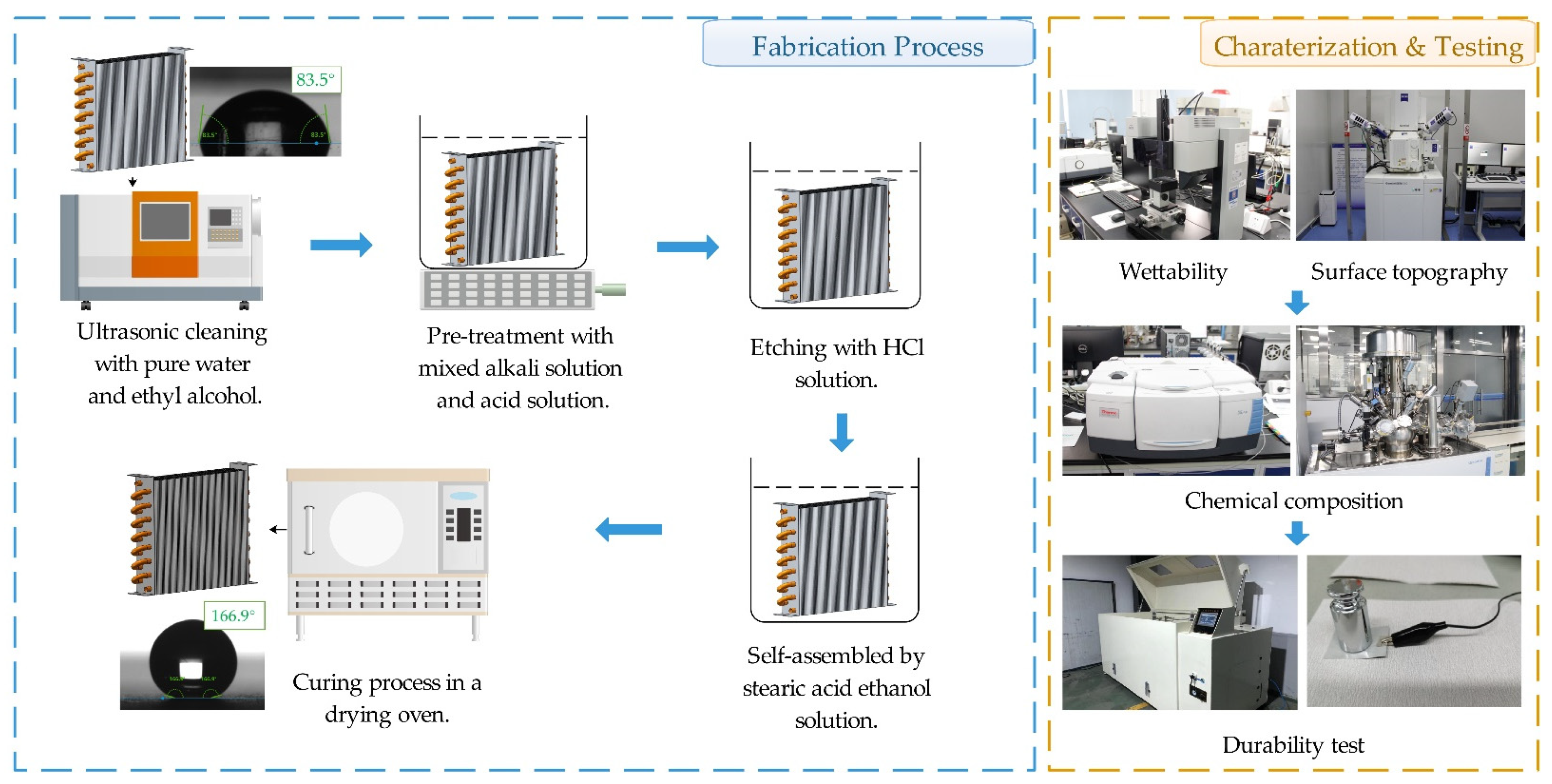
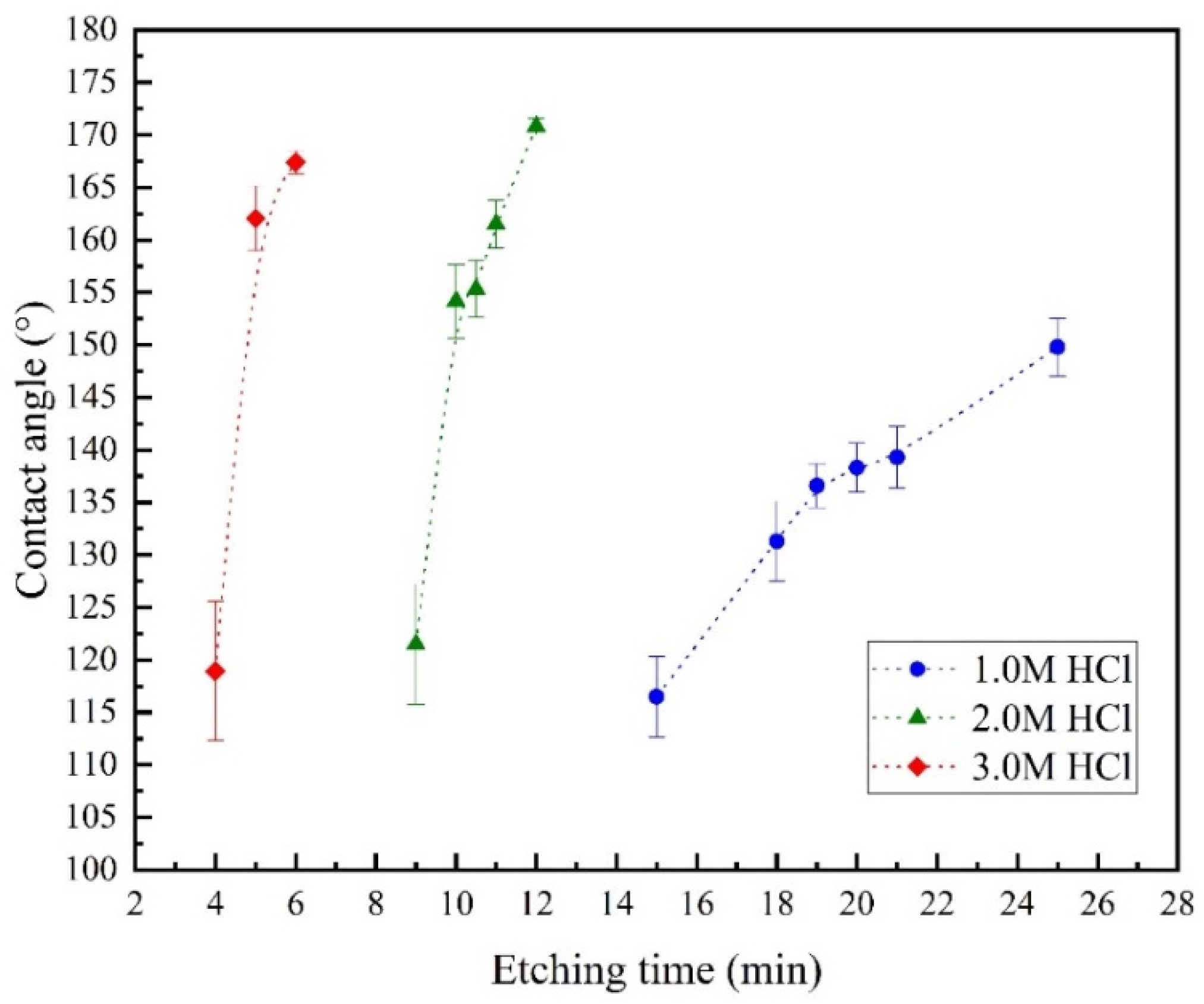

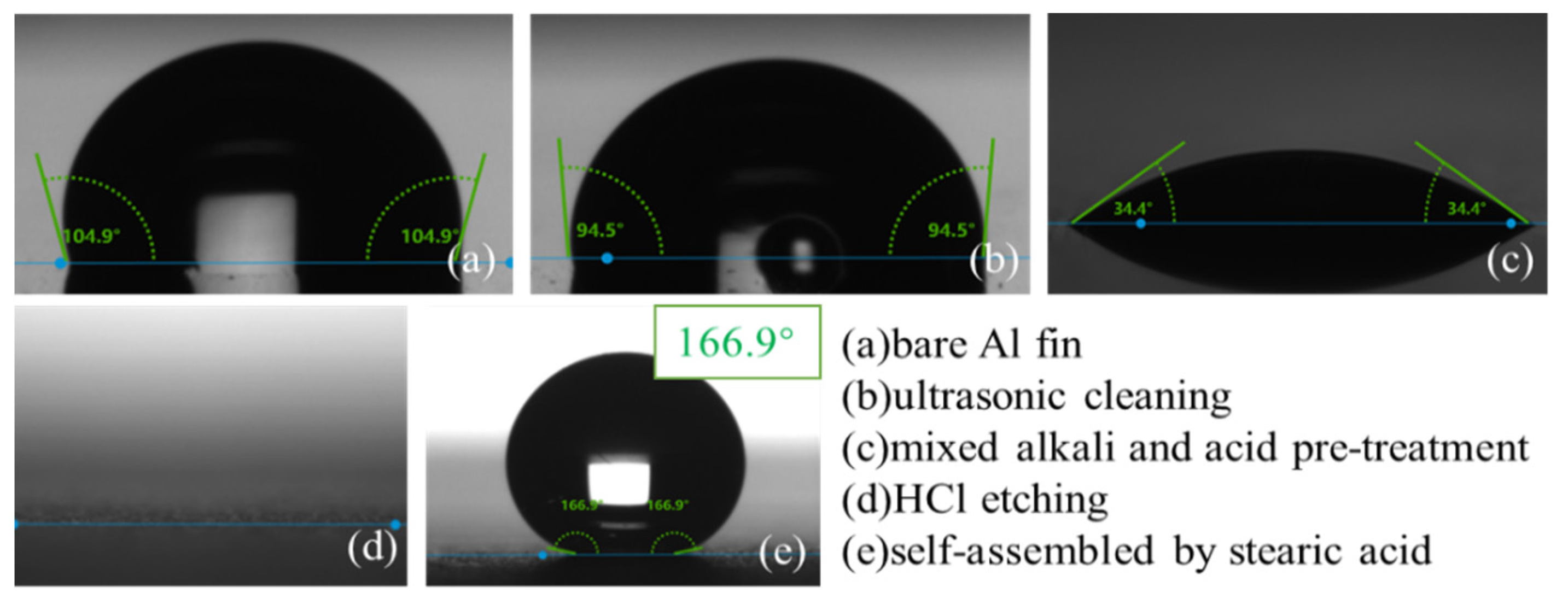
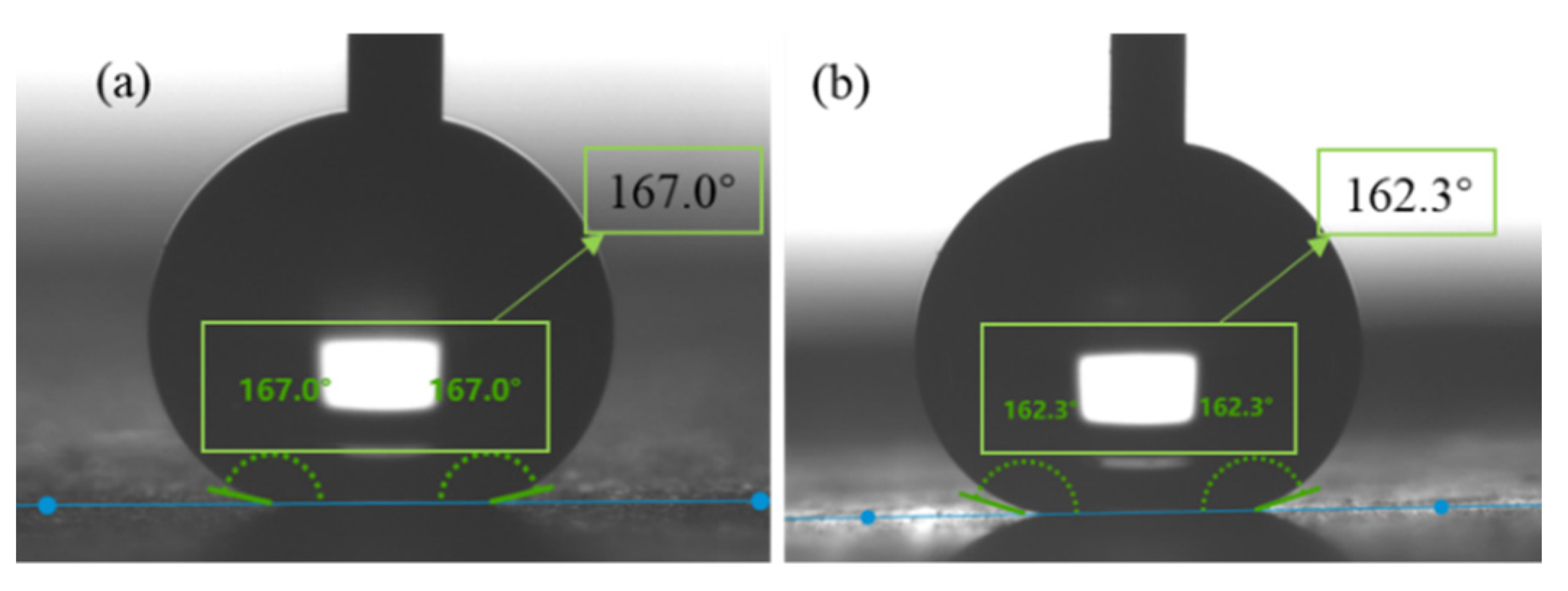

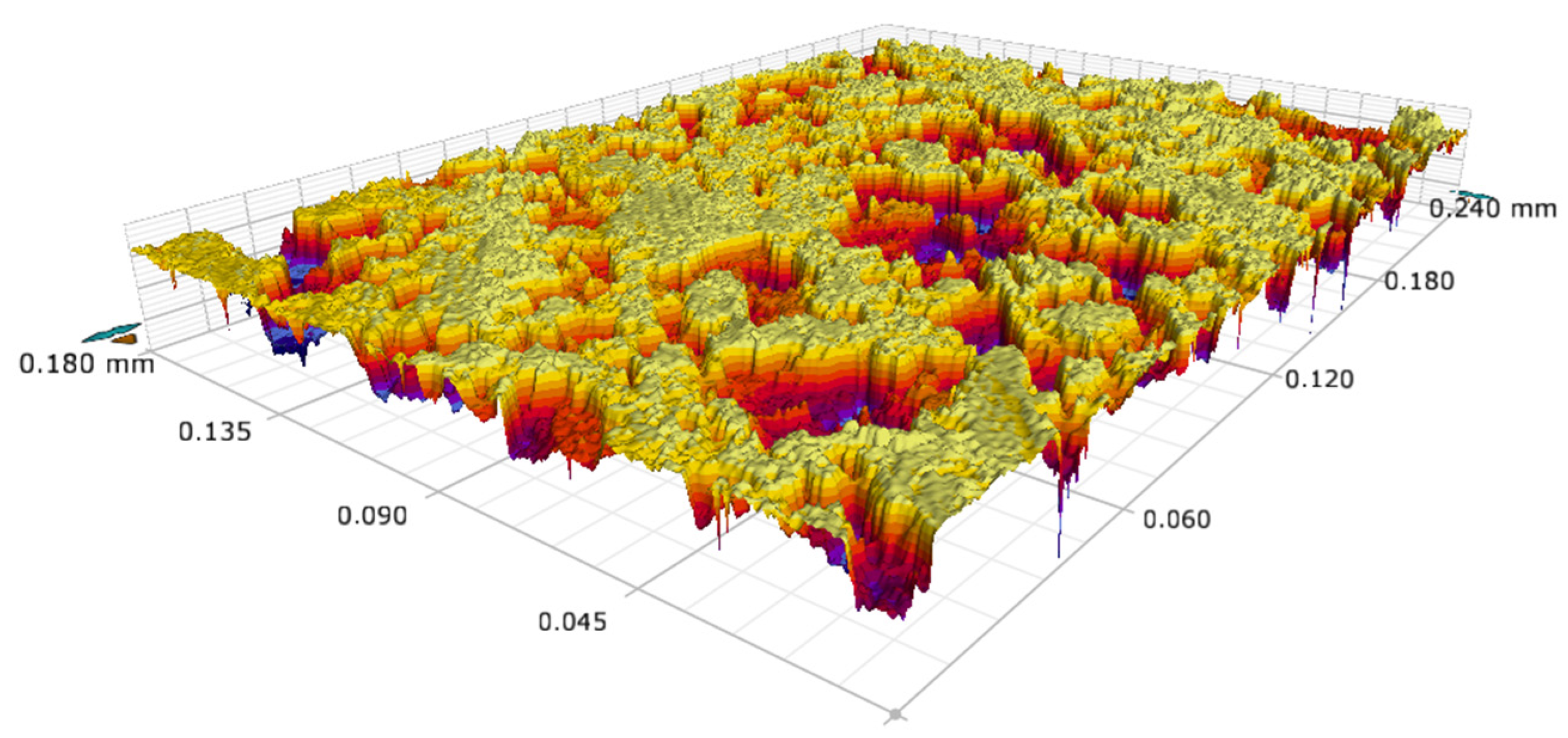
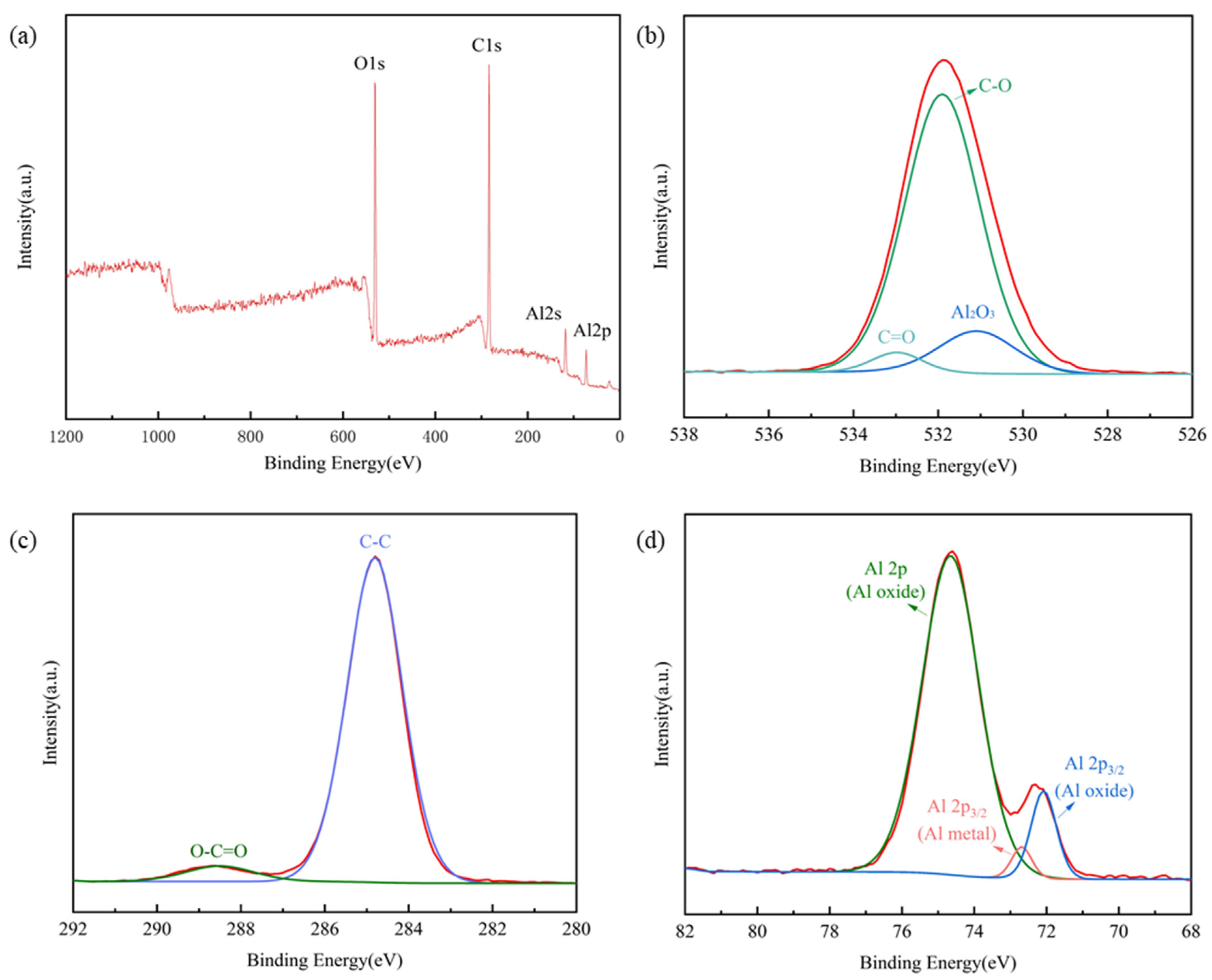

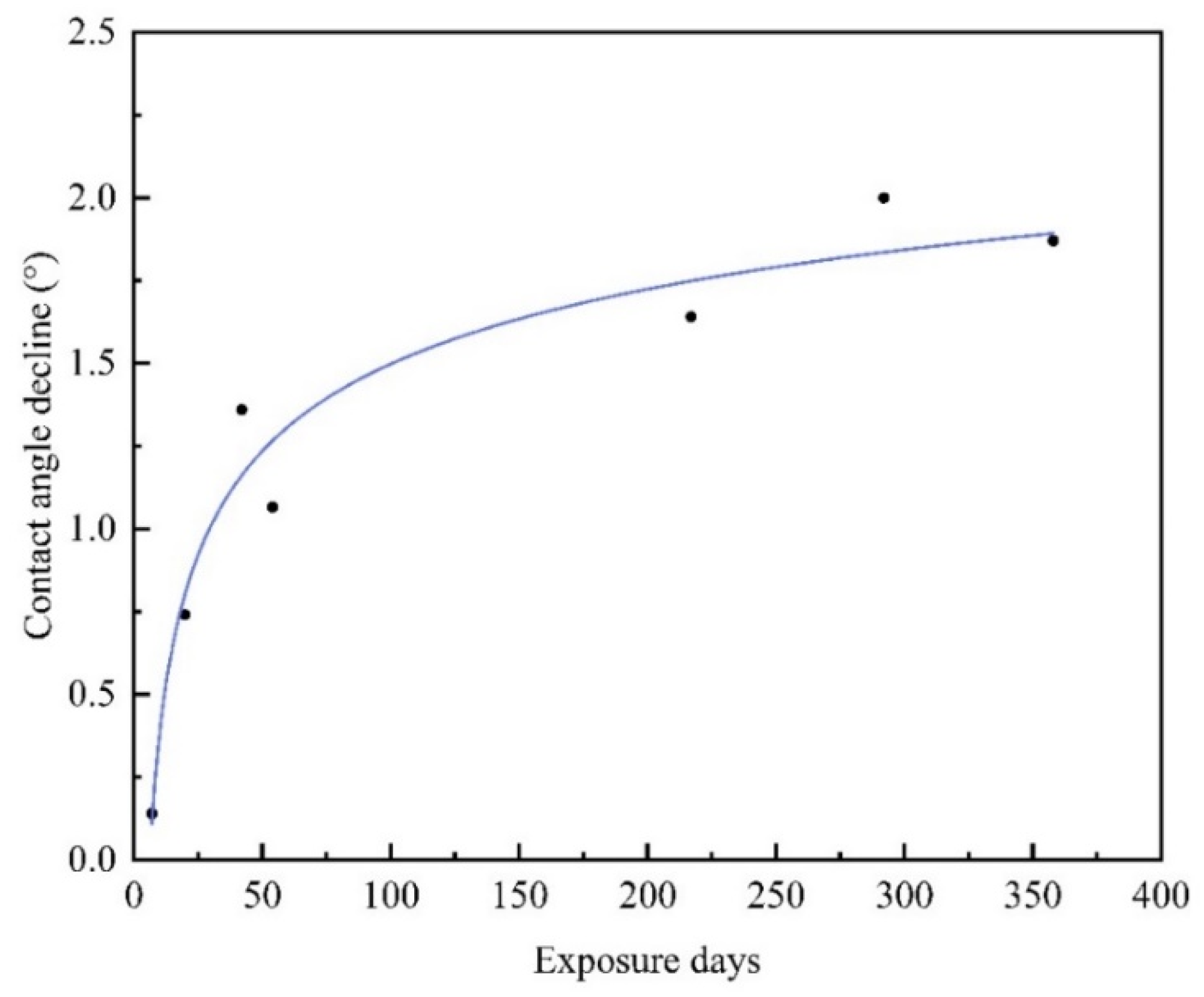
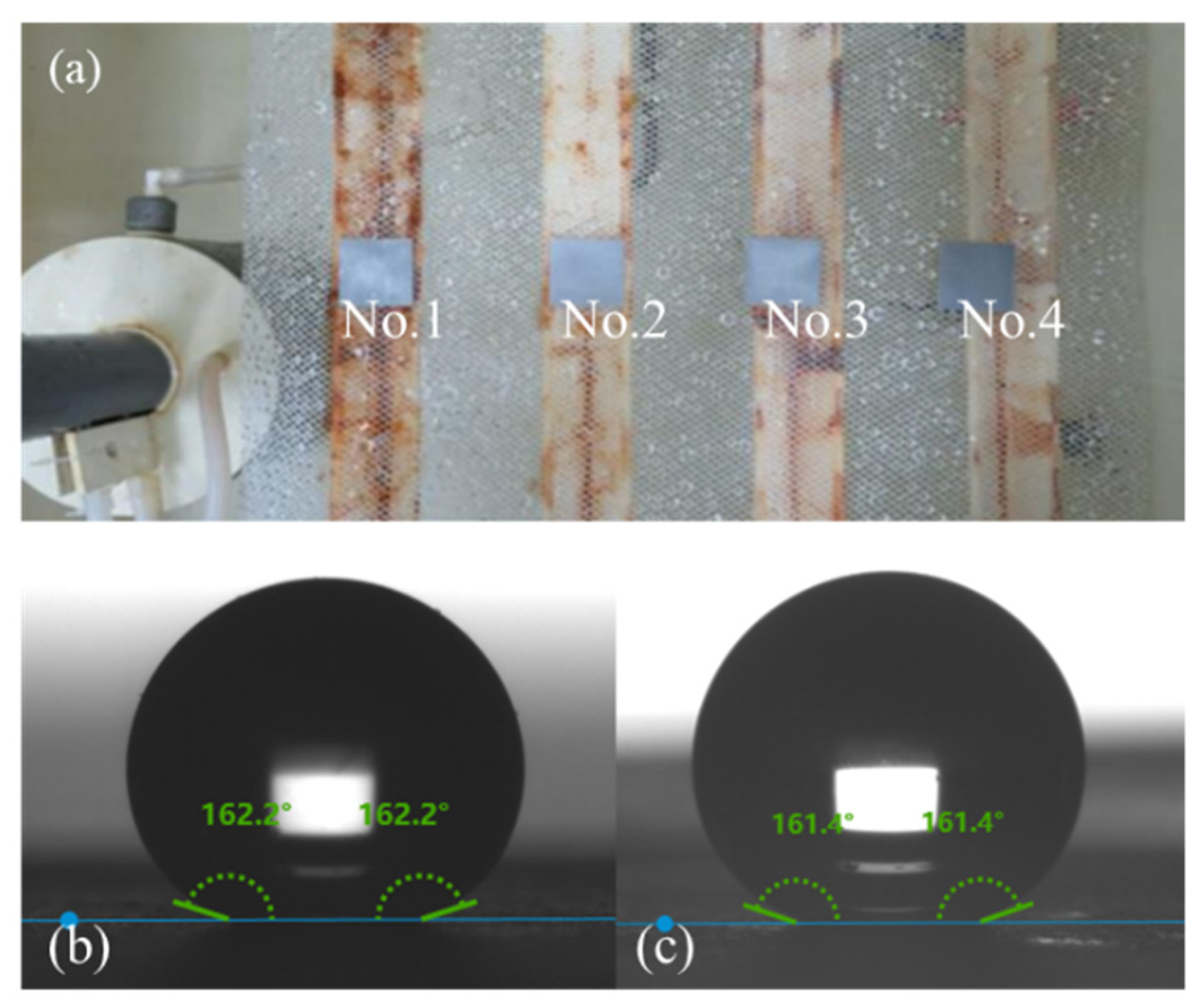
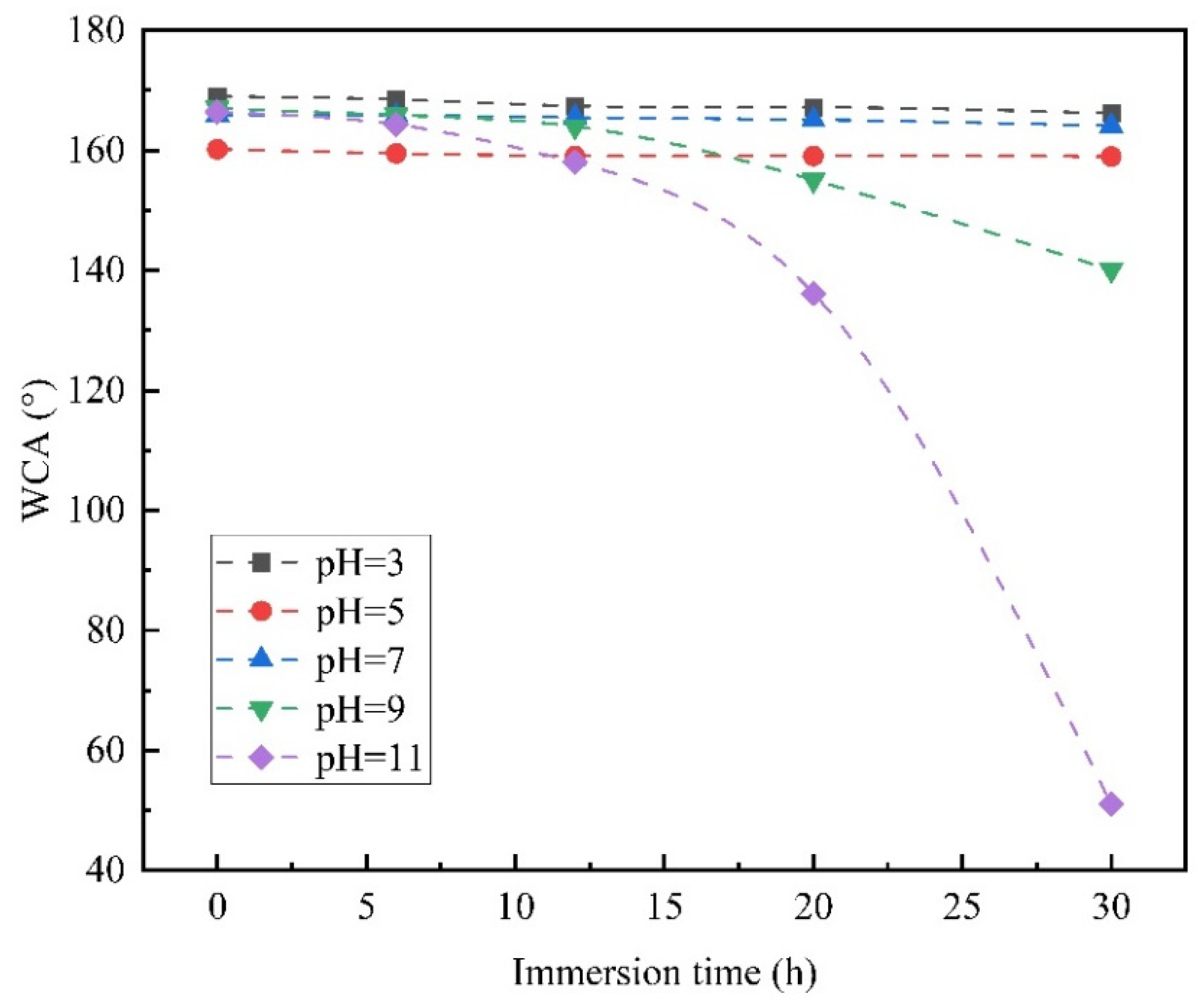
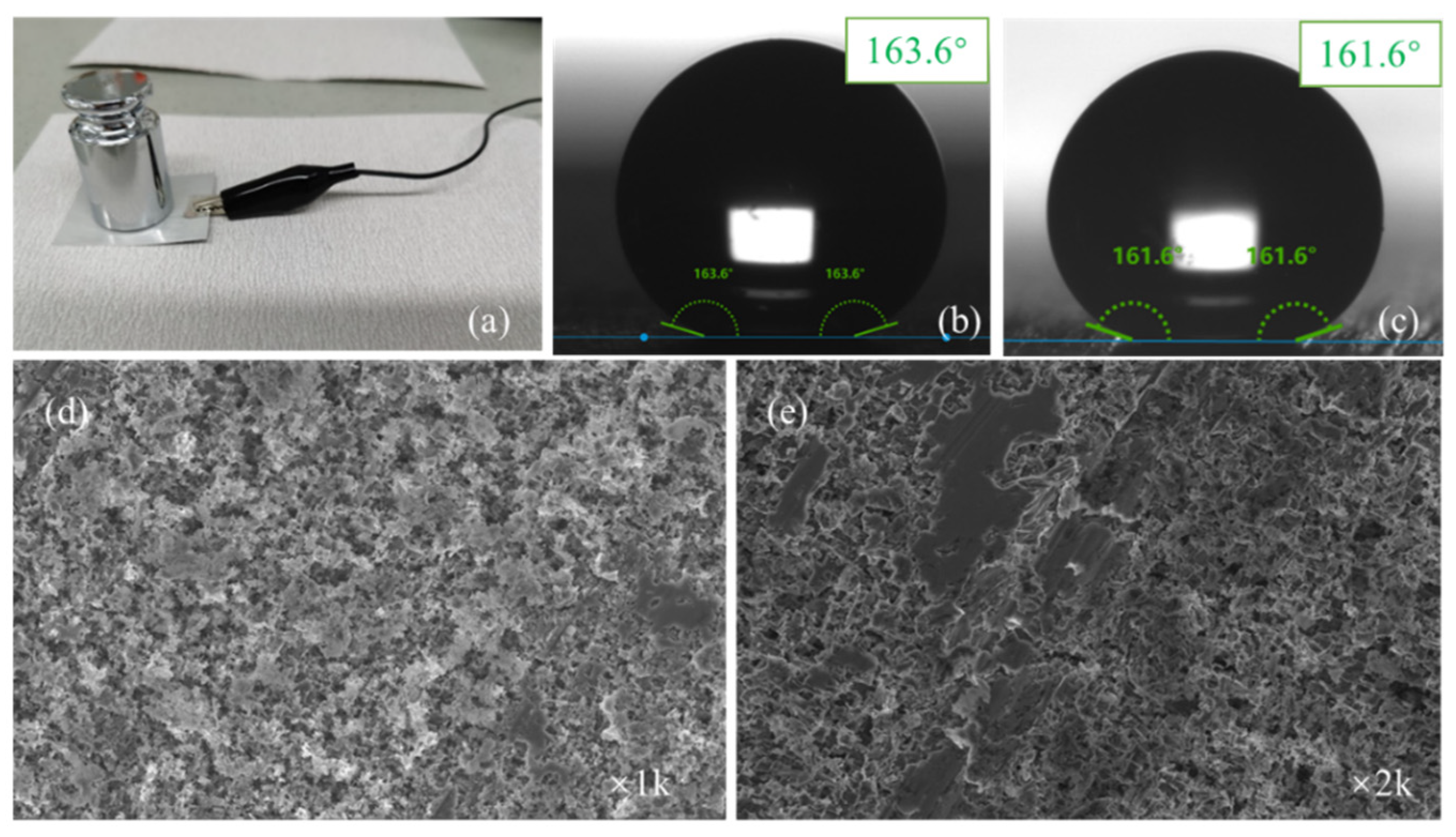

| Influence Factors | Factor Levels | ||
|---|---|---|---|
| −1 | 0 | 1 | |
| Etching time/min | 10.0 | 10.5 | 11.0 |
| Deposition time/h | 24 | 36 | 48 |
| Drying temperature/°C | 70.0 | 80.0 | 90.0 |
| Run | A. Etching Time/min | B. Deposition Time/h | C. Drying Temperature/°C | Response WCA/° |
|---|---|---|---|---|
| 1 | 11.0 | 24 | 80.0 | 157.1 |
| 2 | 11.0 | 48 | 80.0 | 168.6 |
| 3 | 10.5 | 24 | 90.0 | 157.1 |
| 4 | 11.0 | 36 | 90.0 | 168.7 |
| 5 | 10.5 | 24 | 70.0 | 161.5 |
| 6 | 10.5 | 48 | 90.0 | 162.6 |
| 7 | 10.0 | 36 | 70.0 | 152.9 |
| 8 | 11.0 | 36 | 70.0 | 161.8 |
| 9 | 10.0 | 48 | 80.0 | 154.3 |
| 10 | 10.5 | 36 | 80.0 | 160.7 |
| 11 | 10.0 | 36 | 90.0 | 155.0 |
| 12 | 10.0 | 24 | 80.0 | 155.9 |
| 13 | 10.5 | 48 | 70.0 | 159.1 |
| 14 | 10.5 | 36 | 80.0 | 155.3 |
| 15 | 10.5 | 36 | 80.0 | 156.2 |
| 16 | 10.5 | 36 | 80.0 | 160.2 |
| 17 | 10.5 | 36 | 80.0 | 164.4 |
| Source | Sum of Squares | Df | Mean Square | F Value | p Value Prob > F | |
|---|---|---|---|---|---|---|
| Model | 210.78 | 3 | 70.26 | 6.28 | 0.0072 | Significant |
| A | 181.45 | 1 | 181.45 | 16.21 | 0.0014 | |
| B | 21.12 | 1 | 21.12 | 1.89 | 0.1928 | |
| C | 8.20 | 1 | 8.20 | 0.73 | 0.4075 | |
| Residual | 145.53 | 13 | 11.19 | |||
| Lack of Fit | 91.16 | 9 | 10.13 | 0.75 | 0.6733 | Not significant |
| Pure Error | 54.37 | 4 | 13.59 | |||
| Cor Total | 356.31 | 16 |
| Factor | Coefficient Estimate | Df | Standard Error | 95% CI | VIF | |
|---|---|---|---|---|---|---|
| Low | High | |||||
| Intercept | 159.49 | 1 | 0.81 | 157.74 | 161.25 | |
| A | 4.76 | 1 | 1.18 | 2.21 | 7.32 | 1.00 |
| B | 1.63 | 1 | 1.18 | −0.93 | 4.18 | 1.00 |
| C | 1.01 | 1 | 1.18 | −1.54 | 3.57 | 1.00 |
| Sample No. | Initial WCA/° | pH Values of the Aqueous Solutions |
|---|---|---|
| 1 | 169.0 | 3 |
| 2 | 160.2 | 5 |
| 3 | 165.9 | 7 |
| 4 | 167.1 | 9 |
| 5 | 166.4 | 11 |
Publisher’s Note: MDPI stays neutral with regard to jurisdictional claims in published maps and institutional affiliations. |
© 2022 by the authors. Licensee MDPI, Basel, Switzerland. This article is an open access article distributed under the terms and conditions of the Creative Commons Attribution (CC BY) license (https://creativecommons.org/licenses/by/4.0/).
Share and Cite
Li, R.; Wang, Z.; Chen, M.; Li, Z.; Luo, X.; Lu, W.; Gu, Z. Fabrication and Characterization of Superhydrophobic Al-Based Surface Used for Finned-Tube Heat Exchangers. Materials 2022, 15, 3060. https://doi.org/10.3390/ma15093060
Li R, Wang Z, Chen M, Li Z, Luo X, Lu W, Gu Z. Fabrication and Characterization of Superhydrophobic Al-Based Surface Used for Finned-Tube Heat Exchangers. Materials. 2022; 15(9):3060. https://doi.org/10.3390/ma15093060
Chicago/Turabian StyleLi, Ran, Zanshe Wang, Meijuan Chen, Zhang Li, Xiaowei Luo, Weizhen Lu, and Zhaolin Gu. 2022. "Fabrication and Characterization of Superhydrophobic Al-Based Surface Used for Finned-Tube Heat Exchangers" Materials 15, no. 9: 3060. https://doi.org/10.3390/ma15093060
APA StyleLi, R., Wang, Z., Chen, M., Li, Z., Luo, X., Lu, W., & Gu, Z. (2022). Fabrication and Characterization of Superhydrophobic Al-Based Surface Used for Finned-Tube Heat Exchangers. Materials, 15(9), 3060. https://doi.org/10.3390/ma15093060









